In this tutorial, we'll use the ZXing (Zebra Crossing) library to carry out barcode scanning within an Android app. We'll call on the resources in this open source library within our app, retrieving and processing the returned results.
Since we're using the ZXing library, we don't need to worry about users without the barcode scanner installed, because the integration classes provided will take care of this for us. By importing the ZXing integration classes into our app, we can make user scans easier and focus our development efforts on handling the scan results. In a follow-up series coming soon, we'll develop a book scanning app where we'll build on the app we created in this tutorial. We'll also add support for Google Books API so that we can display information about scanned books.
Premium Option: QR-Code & Barcode Reader
If you're looking for a shortcut, you can find some ready-made QR code and barcode readers for Android apps at Envato Market.
For example, QR-Code & Barcode Reader uses the camera of a mobile device to read barcodes and QR codes.
The program automatically recognises the type of encoded data, providing a nice preview and various sharing options. It will add a new contact if the QR code is a business card, or it will send an SMS or call someone depending on the encoded data. Search engine selection is ideal for online product search, price and review comparison.
Automation features like bulk scan mode or auto action open wide opportunities for enterprise integration. The project compilation requires the zBar open-source barcode scanning library, which claims to be the fastest among others available on market and is included here.
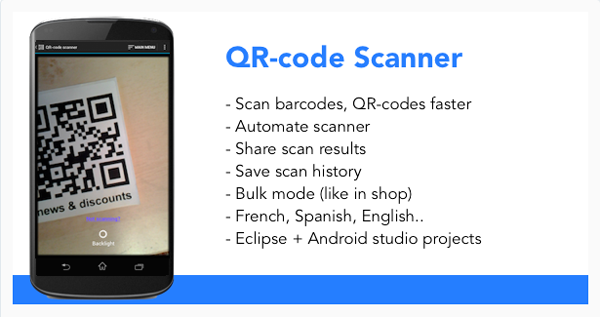
You can search Envato Market for other options to help you, or get an Android app developed on Envato Studio. Otherwise, read on for the full step-by-step instructions for creating a barcode reader yourself.
1. Create a New Android Project
Step 1
In Eclipse, create a new Android project. Enter your chosen application, project, and package names. Let Eclipse create a blank activity for you, with the name of your choice for both the activity and its layout.
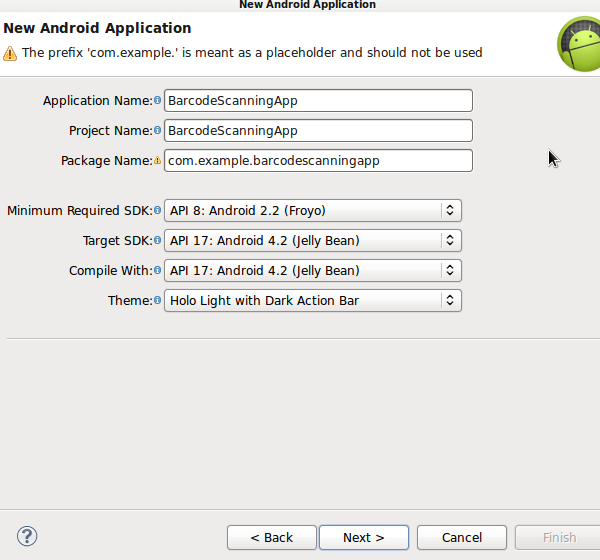
Step 2
Open your main layout file. With the default settings, Eclipse starts your layout with a Relative Layout object, which you can leave as is. Inside of it, replace the existing content (typically a Text View) with a button.
<RelativeLayout xmlns:android="http://schemas.android.com/apk/res/android" xmlns:tools="http://schemas.android.com/tools" android:layout_width="match_parent" android:layout_height="match_parent" > <Button android:id="@+id/scan_button" android:layout_width="wrap_content" android:layout_height="wrap_content" android:layout_centerHorizontal="true" android:text="@string/scan" /> </RelativeLayout>
After the button, add two Text Views in which we will output scanning information.
<TextView android:id="@+id/scan_format" android:layout_width="wrap_content" android:layout_height="wrap_content" android:textIsSelectable="true" android:layout_centerHorizontal="true" android:layout_below="@id/scan_button" /> <TextView android:id="@+id/scan_content" android:layout_width="wrap_content" android:layout_height="wrap_content" android:textIsSelectable="true" android:layout_centerHorizontal="true" android:layout_below="@id/scan_format" />
Add the button text string to your "res/values/strings" XML file.
<string name="scan">Scan</string>
The user will press the button to scan. When the app receives a result from the barcode scanning operation, it will display the scan content data and format name in the two Text Views.
2. Add ZXing to Your Project
Step 1
ZXing is an open source library that provides access to tested and functional barcode scanning on Android. Many users will already have the app installed on their devices, so you can simply launch the scanning Intents and retrieve the results. In this tutorial we are going to use the Scanning via Intent method to make scanning easier. This method involves importing a couple of classes into your app and lets ZXing take care of instances where the user does not have the scanner installed. If the user doesn't have the barcode scanner installed, they'll be prompted to download it.
Tip: Since ZXing is open source, you can import the source code into your projects in its entirety. However, this is really only advisable if you need to make changes to its functionality. You can also compile the project and include its JAR file in your own apps if you prefer. For most purposes, using Scanning via Intent is a reliable and easy to implement options, plus your users will have access to the most recent version of the ZXing app.
In Eclipse, add a new package to your project by right-clicking the "src" folder and choosing "New", then "Package", and entering "com.google.zxing.integration.android" as the package name.
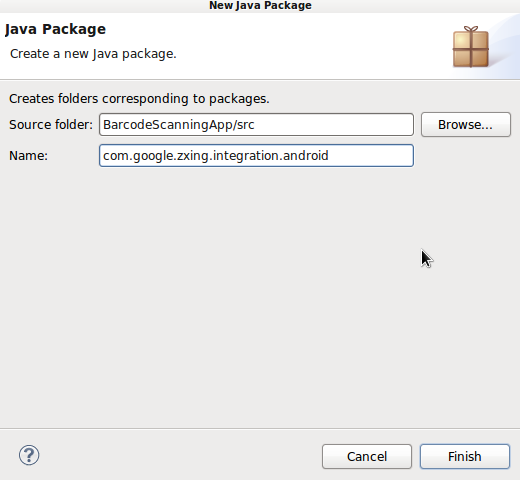
Step 2
Eclipse offers several ways to import existing code into your projects. For the purposes of this tutorial, you'll probably find it easiest to simply create the two required classes and copy the code from ZXing. Right-click your new package, choose "New" then "Class" and enter "IntentIntegrator" as the class name. You can leave the other default settings the way they are. Once you've created this class, do the same for the other class we'll be importing, giving it "IntentResult" as its class name.

Copy the code from both classes in the ZXing library and paste it into the class files you created. These are IntentIntegrator and IntentResult. Refer to the source code download if you're in any doubt about where the various files and folders should be or what should be in them.
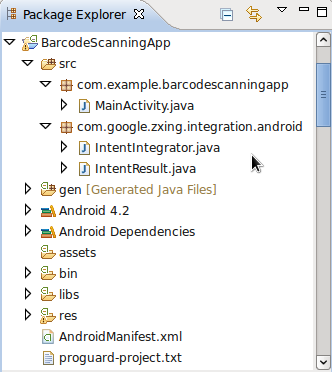
You can now import the ZXing classes into your main Activity class.
import com.google.zxing.integration.android.IntentIntegrator; import com.google.zxing.integration.android.IntentResult;
Go ahead and add the other import statements we'll use for this tutorial. Bear in mind that Eclipse may have already added some for you.
import android.os.Bundle; import android.app.Activity; import android.content.Intent; import android.view.View; import android.view.View.OnClickListener; import android.widget.Button; import android.widget.TextView; import android.widget.Toast;
Feel free to have a look at the content of the two ZXing classes. It's fairly straightforward, but the details of the barcode scanning processing are carried out elsewhere in the library. These two classes really act as an interface to the scanning functionality.
3. Do Some Scanning
Step 1
Let's implement scanning when the user clicks the button we added. In your app's main activity class, the default onCreate method entered by Eclipse should look something like this.
protected void onCreate(Bundle savedInstanceState) {
super.onCreate(savedInstanceState);
setContentView(R.layout.activity_main);
}
Above this method, add the following instance variables to represent the button and two Text Views we created in the layout file.
private Button scanBtn; private TextView formatTxt, contentTxt;
In onCreate, after the existing code, instantiate these variables using the ID values we specified in the XML.
scanBtn = (Button)findViewById(R.id.scan_button); formatTxt = (TextView)findViewById(R.id.scan_format); contentTxt = (TextView)findViewById(R.id.scan_content);
Next, add a listener to the button so that we can handle presses.
scanBtn.setOnClickListener(this);
Extend the opening line of the class declaration to implement the OnClickListener interface.
public class MainActivity extends Activity implements OnClickListener
Step 2
Now we can respond to button clicks by starting the scanning process. Add an onClick method to your activity class.
public void onClick(View v){
//respond to clicks
}
Check whether the scanning button has been pressed inside this method.
if(v.getId()==R.id.scan_button){
//scan
}
Inside this conditional block, create an instance of the Intent Integrator class we imported.
IntentIntegrator scanIntegrator = new IntentIntegrator(this);
Now we can call on the Intent Integrator method to start scanning.
scanIntegrator.initiateScan();
At this point, the scanner will start if it's installed on the user's device. If not, they'll be prompted to download it. The results of the scan will be returned to the main activity where scanning was initiated, so we'll be able to retrieve it in the onActivityResult method.
Tip: When you call the initiateScan method, you can choose to pass a collection of the barcode types you want to scan. By default, the method will scan for all supported types. These include UPC-A, UPC-E, EAN-8, EAN-13, QR Code, RSS-14, RSS Expanded, Data Matrix, Aztec, PDF 417, Codabar, ITF, Codes 39, 93, and 128. The ZXing library also includes barcode scanning options that we're not going to cover in this tutorial. You can check the project out at Google Code for more info.
4. Retrieve Scanning Results
Step 1
When the user clicks the scan button, the barcode scanner will launch. When they scan a barcode, it will return the scanned data to the onActivityResult method of the calling activity. Add the method to your main activity class.
public void onActivityResult(int requestCode, int resultCode, Intent intent) {
//retrieve scan result
}
Inside the method, try to parse the result into an instance of the ZXing Intent Result class we imported.
IntentResult scanningResult = IntentIntegrator.parseActivityResult(requestCode, resultCode, intent);
Step 2
As with any data being retrieved from another app, it's vital to check for null values. Only proceed if we have a valid result.
if (scanningResult != null) {
//we have a result
}
If scan data is not received (for example, if the user cancels the scan by pressing the back button), we can simply output a message.
else{
Toast toast = Toast.makeText(getApplicationContext(),
"No scan data received!", Toast.LENGTH_SHORT);
toast.show();
}
Back in the if block, let's find out what data the scan returned. The Intent Result object provides methods to retrieve the content of the scan and the format of the data returned from it. Retrieve the content as a string value.
String scanContent = scanningResult.getContents();
Retrieve the format name, also as a string.
String scanFormat = scanningResult.getFormatName();
Step 3
Now your program has the format and content of the scanned data, so you can do whatever you want with it. For the purpose of this tutorial, we'll just write the values to the Text Views in our layout.
formatTxt.setText("FORMAT: " + scanFormat);
contentTxt.setText("CONTENT: " + scanContent);
Run your app on a device instead of an emulator so that you can see the scan functioning. Try scanning a book or any other barcode you might have.
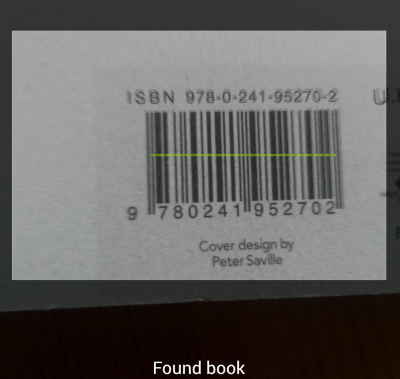

Conclusion
In this tutorial, we've run through the process of facilitating barcode scanning within Android apps using the ZXing library. In your own apps, you might want to carry out further processing on the retrieved scan results, such as loading URLs or looking the data up in a third party data source. In the follow-up to this tutorial, we'll use the barcode scanning functionality to create a book scanning app that will allow us to retrieve data about scanned books from the Google Books API.
Don't forget that if you're having trouble creating the barcode reader yourself, you can find some ready-made options on Envato Market to help you.


Comments